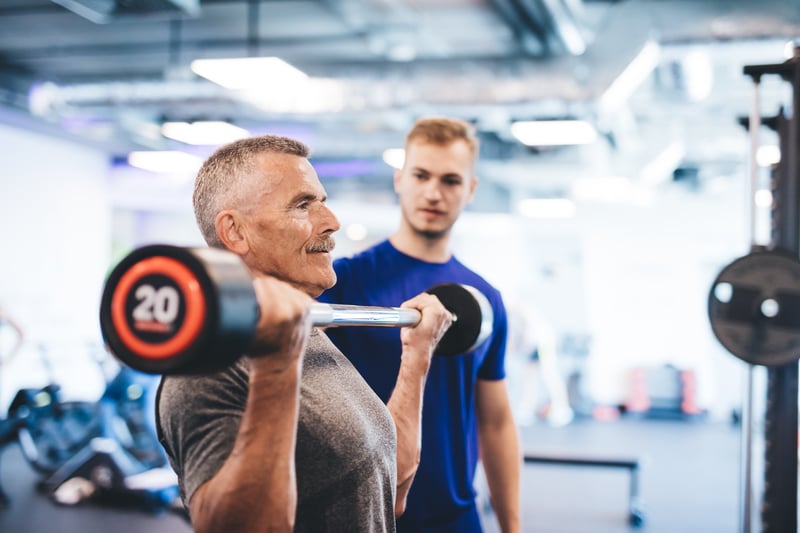10 Reasons Why Muscular Strength is Key to Longevity

“Only the strong survive…” It’s such a beautiful title. And it’s so much more than a play on the “survival of the fittest” moniker deeply rooted in Charles Darwin’s evolutionary theory. It’s not just a play on words either. It’s a very literal translation of one of the single-most important factors dictating how long and how well you live your life: Muscle Strength. Yes, you read that correctly. If you don’t believe it, just wait ‘til I reveal all the fascinating, if not surprising, ways that building (and maintaining) strong, healthy muscles helps you kick butt and take names through a long, productive, and meaningful health span.
The Relationship Between Muscular Strength and Longevity
If I were to ask you what the most important factors and predictors of living a long life are, what kinds of things come to mind? Genetics? Sure, they play a role (much less than you might think, though). What about lifestyle factors?
Is weight management—especially belly fat—on the tip of your tongue? How about nutrition? Gotta eat your fruits and veggies, no? Social support and connectedness? Surely. Stress, don’t you think? Oh, and exercise, especially good ol’ cardio, right?
What about muscle strength? Would that have even been on your radar had it not been for the title? I suspect that most people would be quite surprised to learn that muscle strength is one of the strongest predictors of how long you will live.
A seminal review study, which involved 8,762 male participants who were followed nearly 19 years (it ended up involving 165,251 person years of observation), published in the British Medical Journal, found that “muscular strength is inversely and independently associated with death from all causes and cancer.” And that was even after taking into consideration other confounding factors like cardiorespiratory fitness. 1
I’m not just talking about statistical significance. I’m talking about game-changing significance. For example, men in the lowest third of muscle strength—which was quantified by bench press (upper body) and leg press (lower body) performance—had a 50% greater rate of death during the study period compared to men in the middle and upper thirds of muscular strength. What’s more, low muscular strength was associated with an 83% increased risk of death from cardiovascular disease and 45% increased risk of death from cancer compared to stronger men.
Since that remarkable study was published, even more evidence has mounted highlighting this important connection between muscular strength and lifespan. For instance, a recent study published in the journal Medicine and Science in Sports and Exercise, which included 4,449 participants (≥ age 50) from the National Health and Nutrition Examination Survey, found that death from all causes was 2.66 TIMES higher in folks with low muscle strength. 2
Perhaps most impressive are the findings from a recent systematic review and meta-analysis, which analyzed data from 38 studies involving 1,907,580 participants—yes, that’s nearly 2 MILLION people. The researchers found “higher levels of upper- and lower-body muscular strength are associated with a lower risk of mortality in adult population, regardless of age and follow-up period.”
We’re talking about a 30% reduced risk of death overall. And believe it or not, women with higher levels of muscular strength had a 40% reduced rate of all-cause mortality. 3
I know I’m throwing a lot of numbers at you. To sum things up, check out what Dr. Keith Baar, Professor at the Department of Physiology and Membrane Biology in the UC-Davis School of Medicine, had to say in an interview with Dan Pardi on humanOS radio: 4
“The big thing that we know is that if you’re in the strongest third of the population, you’re two-and-a-half times more likely to make it to your hundredth birthday, and that’s if you’re in the strongest third of the population at midlife. If you’re in your 50s and you’re one of the strongest 50-year-olds, you’re two and a half times more likely to make it to 100. In humans, the number one correlate with longevity seems to be muscle mass and strength because basically the stronger you are the more you can survive certain diseases.”
But here’s something even more important: Muscular strength doesn’t just increase lifespan. Having strong, healthy muscles enhances health span.
What is health span? Great question.
Researchers define health span as “the period of life free of major chronic clinical diseases and disability.” It’s based on the premise that life can be roughly divided into two phases: a period of relatively healthy aging (health span) and a period of age-associated disease and disability. 5,6
Another way to think about health span is optimal longevity, which means living long with an even greater interest in living well. In other words, increasing health span isn’t just about surviving longer. It’s about living longer. This is an important distinction to make. Despite the fact that medical advances have resulted in an increased average lifespan, many would argue this is the result of folks surviving longer with age- and lifestyle-associated diseases and disabilities—rather than by increasing health span. 6
10 Ways Strong, Healthy Muscles Optimize Longevity
How does muscular strength enhance health span and optimize longevity? To answer that question, we need look no further than the health-related benefits of resistance training—the most effective tool for enhancing muscular strength.
I have a feeling you may be surprised when you find out that lifting weights does more than simply increase strength and muscle mass—two benefits it can markedly and reliably improve. And my hope is you’ll also recognize that pumping iron isn’t just for athletes, bodybuilders, and the like.
Let me put it in no uncertain terms: Resistance training is essential for EVERYONE. Here are 10 ways it can help you live longer, better, and more optimally. 7,8
1) Resistance training enhances muscle strength, power, endurance, quality, and mass.
Duh, right? Even though this goes without saying, the health consequences of maintaining (and increasing) muscle strength, power, and mass over the years can’t be overstated (see below). Healthy levels of these variables help protect you from physical disability, falling, and even death. Of course, they’re intricately tied to physical performance and functional capacity.
2) Resistance training helps reduce body fat and visceral (belly) fat.
Even though lifting weights (by itself) may not lead to “weight loss” on the scale (i.e., a net reduction in body mass), it can radically change the shape of your body—how you look and feel and how your clothes fit—as it helps you reduce body fat while increasing lean muscle. Most importantly, resistance training helps decrease belly fat, which is associated with metabolic syndrome and increased risk of type 2 diabetes and cardiovascular disease.
3) Resistance training helps maintain (or even increase) resting metabolic rate and prevent age-associated fat gain.
An age-related decline in metabolic rate—which coincides, not ironically, with an age-related decline in muscle—plays a significant role in age-related fat gain, which contributes to reductions in quality of life and health span. (Note that “age-related” could be substituted with “lifestyle-related” in all these instances.) Muscle is metabolically active. It accounts for up to 50% of the total calories burned each day. In theory, a gain of 2.2 pounds in muscle mass should increase resting metabolic rate by more than 20 calories per day.
4) Resistance training helps reduce fasting insulin levels, improve insulin sensitivity, and reduce the insulin response to carbohydrates.
For starters, muscle is the primary site where the body uses and stores glucose (carbohydrate). And muscle contraction increases glucose uptake and improves insulin sensitivity, which help promote glycemic balance and control. It’s no wonder the American Diabetes Association recommends that all adults should engage in regular resistance training. 9
5) Resistance training can help increase HDL, reduce triglycerides, and improve blood pressure.
Low HDL, high triglycerides, and high blood pressure (along with elevated waist circumference and fasting blood glucose) contribute to an elevated risk for metabolic syndrome. Muscle strength has been inversely associated with metabolic syndrome, and there is some evidence that resistance training may improve HDL, triglycerides, and blood pressure. 10
6) Resistance training can increase bone mineral density (BMD).
Long-term studies have shown lifting weights can significantly increase bone mass in men and women of all ages. BMD is a tremendous concern, especially among women, as folks get older because it is intricately tied to osteoporosis and the risk for broken bones.
7) Resistance training can help boost mood.
That’s right, the benefits of resistance training go beyond strong, healthy muscles. In a recent systematic review and meta-analysis involving 33 clinical trials including 1,877 participants, researchers found resistance training significantly reduced depressive symptoms among adults. 11
8) Resistance training can improve cognitive function.
Yep, lifting weights promotes a healthy brain, not just brawn, and emerging research is demonstrating that resistance training can improve cognitive function and quality of life in older folks. 12
9) Resistance training can protect against injuries.
When you think about staying physically healthy and reducing your risk for injury, what type of exercise or activity usually comes to mind? If stretching activities are at the top of the list, it’s time to reconsider. Not only does research show that stretching has NO beneficial impact on injury prevention, it tells us that strength training reduces the risk of injuries by nearly 70%. In other words, regularly lifting weights reduces the incidence of injury to less than 1/3. 13
10) Resistance training can improve quality of life.
While quality of life can have a unique meaning to each individual, it generally is a function of one’s ability to do what is enjoyed and required to remain independent. Along those lines, resistance training is essential to maintaining the muscle strength and endurance to perform various activities of daily living and remaining physically independent. It’s no surprise resistance training improves health-related quality of life.
If that doesn’t get you excited about building muscle and you can not appreciate the link between muscular strength and longevity, I’m not sure what will.
You Can’t Afford Not to (Lift)
Here’s the deal: As you get older, simply maintaining hard-earned muscle is an uphill battle. For instance, research shows that adults experience profound losses in muscle mass after reaching the age of 30. Losses begin at about 3 – 8% per decade, and the rate accelerates to losses of 1 – 2% of muscle mass each year once folks hit their 50s.
Ultimately, from the time you’re 20 to the time you hit your 80s, it’s likely that you’ve lost between 35 – 40% of your muscle. 14,15 Yikes!
To make matters worse, we tend to get weaker faster than we get smaller. That is, strength goes down about three times as fast as muscle mass, with research suggesting that strength losses range from 1.5 – 5% each year. 15 To put it into perspective, one out of five adults 55 and older have difficulty walking 10 steps. More than 25% have trouble standing for two hours, 30% have difficulty stooping or bending, and 15% of adults age 55 and over have difficulty carrying 10 pounds—real-life problems that only get considerably worse with age. Yowza!
Thankfully, scientists recognize this to be a critically important topic. In recent years, there has been an enormous investment into better understanding sarcopenia (i.e., age-related muscle loss) and dynapenia (i.e., age-related loss of muscle strength), associated with increased frailty and risk of falls, loss of independence, lower survival during injury and while battling diseases (e.g., cancer), and as mentioned above, a higher risk of death from any cause.
Use It or Lose It
While we don’t know all the answers, we can draw some key, practical takeaways for protecting—and even building—muscle strength and mass into and beyond your silver, golden, and platinum years. I’m not sure “platinum years” is even a “thing,” but I think you catch my drift: Getting smaller and weaker is not inevitable.
And while there are arguably many more factors at play, the two most powerful tools in the muscle- and strength-building toolbox are resistance training and protein intake. When you combine them consistently, they converge to form the ultimate synergy to building muscle and strength. 17
Resistance training. When it comes to building and maintaining muscle mass, the good news is that virtually any amount of weight can do the trick. The most important variable is your degree of effort. In other words, you can use light or heavy weights—even your body weight—as long as you push yourself ‘til you can’t do any more.
While the size of a muscle can be somewhat telling of the amount of force it can produce, there’s a bit more to the strength side of the equation beyond muscle size. In other words, growing muscle doesn’t always mean increasing strength at a proportionate rate. Along those lines, if we want to focus on building strength, then we need to emphasize lifting heavier weights.
Having said that, for most people looking to optimize muscular strength and longevity, any approach is likely to get the job done. My suggestion would be to incorporate a progressive resistance training program that gets more challenging and diversified as you get more experience under your belt.
For example, if you’re not doing any sort of resistance training, then just start with some bodyweight exercises, like push-ups and squats, and do them until you can’t do any more. Each time you exercise, try to add another repetition and/or add another set (e.g., start with one set and work up to four).
Ultimately, I like full-body workouts that emphasize all the major muscle groups and focus on compound movements, like squats, presses, and rows. You can start with 1 – 2 workouts per week, and ideally, work your way up to lifting weights every other day (i.e., 3 – 4 times per week). On average, research suggests performing at least 10 weekly sets per muscle group to support increases in muscle mass, although there’s a dose-dependent relationship that may be more applicable as we get older. 18
Research shows that as we get older, our bodies seem to be less responsive to the stimulus resistance training imparts. If it wasn’t already an uphill battle, we probably need to do more volume and train more frequently to get the best muscle- and strength-building results. 19,20
Eat for GAINZ. Alongside pumping iron, consumption of dietary protein is another pillar in building muscle and strength. There is no shortage of articles on the importance of higher-protein intakes here on the blog. As it pertains to the present topic, here’s some relevant and important reading material:
- Protein Intake FAQ: How Much Protein Do I Need?
- Ask the Coaches: How Much Protein Is Too Much?
- High-Protein Diet: What Are the Benefits (and is it right for you)?
In general, as we get older, we’re more likely to consume a suboptimal protein intake, which contributes to age-related muscle loss. 21 Ironically, as we age, we have a reduced sensitivity to the effects of dietary protein. (This is the other aspect of the anabolic resistance equation.) In other words, more dietary protein is needed to help build and maintain skeletal muscle mass as we age. 22,23 In fact, it may take up to 67% more protein per meal for older adults to stimulate muscle protein synthesis to a comparable level as young adults.
While the articles linked above delve into protein consumption in the depth it deserves, generally speaking, research suggests consuming about 0.7 – 1.0 grams of protein per pound of body weight per day is optimal. Although I don’t think it’s necessary to eat more than 3 meals per day (and you could argue for less, at least on some days, for optimal longevity), it does seem like getting roughly 35 – 40 grams of protein per feeding is a good target.
While protein timing is probably not as important as once thought, it does seem like it’s more important as we get older to consume a high-quality source of protein that’s rich in essential amino acids, particularly leucine (e.g., whey protein) within an hour or so after exercise. And like I talked about in this article, I think it might be a good idea to consume some hydrolyzed collagen peptides about an hour or so before working out to support tendon/ligament health and recovery.
Muscular Strength and Longevity: A Recap
When it comes to exercise, I admit that I’m a bit biased with a preference toward lifting weights. After all, this is coming from a guy with a sports background, a Master’s degree in exercise physiology, and specialized training as a strength and conditioning specialist. But lifting weights isn’t just for athletes and bodybuilders. It’s for EVERYONE… well, at least everyone who wants to optimize longevity and enjoy a long life marked by good health, function, productivity, and independence.
See you in the gym!









